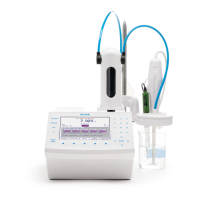13
ACIDITY OF WATER
ACIDITY OF WATER
0 to 2500 mg/L, pH 8.3 Endpoint
METHOD ID: HI1005EN
DESCRIPTION
Method for the determination of total (phenolphthalein) acidity in
water by titration of a sample to pH 8.3. The results are expressed in
mg/L (ppm) as calcium carbonate.
For the determination of methyl orange acidity, set the endpoint to
pH 3.7.
REFERENCE
Standard Methods for the Examination of Water and Wastewater
21
st
edition, Method 2310B
ELECTRODE
• HI1131B Combination pH Electrode
• HI7662-T Temperature Probe
REAGENTS
• HI70456 0.1N Sodium Hydroxide (1 L)
• HI70436 Deionized Water (1 gal)
ACCESSORIES
• HI70300L Storage Solution (500 mL)
• HI7082 Electrode Fill Solution (4 x 30 mL)
• HI7004L pH 4.01 Buffer Solution (500 mL)
• HI7007L pH 7.01 Buffer Solution (500 mL)
• HI7010L pH 10.01 Buffer Solution (500 mL)
• HI740036P 100 mL Plastic Beaker (10 pcs)
• 50 mL Class A Volumetric Pipette
DEVICE PREPARATION
• Connect the pH electrode and temperature probe to the titrator.
• Install a 25 mL burette filled with 0.1N sodium hydroxide
(HI70456) on pump one and verify that no air bubbles are
present in the burette or tubing. If necessary prime the burette
until all the air has been removed completely.
• For the determination of the exact concentration of the 0.1N
sodium hydroxide, follow HI0001EN 0.1N Sodium Hydroxide
Titrant Concentration.
• Press from the main screen. Use the arrow keys to
highlight Acidity of Water and press .
ELECTRODE PREPARATION
• Press from the main screen, if necessary select the
analog board and press .
• Calibrate the electrode using pH 4.01, 7.01 and 10.01 buffers.
Refer to the instruction manual for calibration procedure.
SAMPLE PREPARATION
• Use a Class A volumetric pipette to transfer exactly 50.00 mL of
sample to a clean 100 mL plastic beaker.
ANALYSIS
• Place the beaker under the stirrer assembly and lower it to
immerse the pH electrode, temperature sensor and stirrer.
Ensure that the reference junction of the pH electrode is 5 to 6
mm below the surface. If necessary add extra deionized water.
Note: The dispensing tip should be slightly submerged in the
sample.
• Press , the titrator will start the analysis.
• At the end of the titration, when pH 8.30 is reached, “Titration
Completed” will appear with the result. The result is expressed
in mg/L as calcium carbonate.
• Remove the pH electrode, temperature probe and stirrer from the
sample and rinse them thoroughly with deionized water.
• Record the result.

